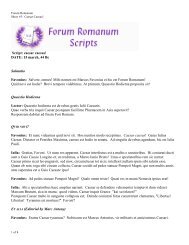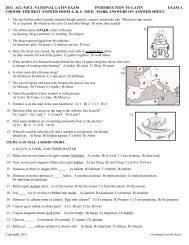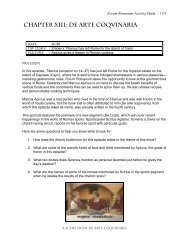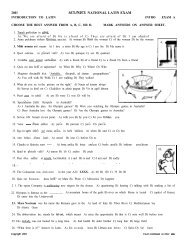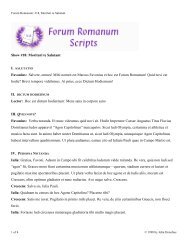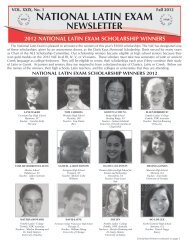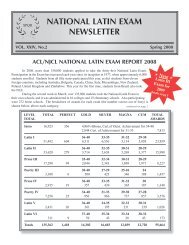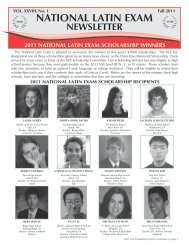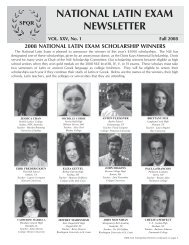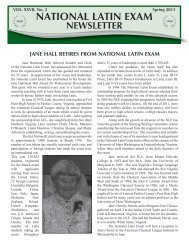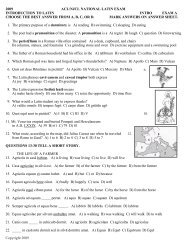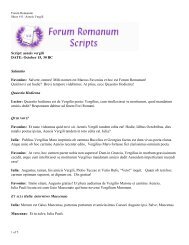Create successful ePaper yourself
Turn your PDF publications into a flip-book with our unique Google optimized e-Paper software.
26. Complete the following analogy: Clytemnestra is to Agamemnon as _____ is to Menelaus A) Hecuba B) Iphigenia<br />
C) Penelope D) Helen<br />
27. Roman writers such as Horace, Petronius, Martial and Juvenal are credited with establishing the literary genre<br />
A) satire B) epic poetry C) epistles D) biography<br />
28. Which <strong>Latin</strong> phrase is associated with the start of Christianity being accepted in the later Roman Empire?<br />
A) In hoc signo vinces B) Non omnia possumus omnes C) Sic transit gloria mundi D) Nihil sub sole novum<br />
READ THE PASSAGE AND ANSWER THE QUESTIONS.<br />
CAESAR'S OMEN<br />
<strong>The</strong> image of distraught Roma appears at a crucial moment.<br />
Iam gelidās Caesar cursū superāverat Alpēs 1<br />
ingentēsque animō mōtūs bellumque futūrum 2<br />
cēperat. Ut ventum est parvī Rubicōnis ad undās, 3<br />
ingēns vīsa ducī patriae trepidantis imāgō 4<br />
clāra per obscūram vultū maestissima noctem 5<br />
et gemitū permixta loquī: ‘Quō tenditis ultrā? 6 loquī = she spoke<br />
Quō fertis mea signa, virī? Sī iūre venītis, 7<br />
sī cīvēs, hūc usque licet.’ Tum percussit horror 8 usque = up to<br />
membra ducis, riguēre comae gressumque coercēns 9<br />
languor in extrēmā tenuit vēstīgia rīpā. 10 languor = sluggishness; rīpā = riverbank<br />
mox ait ‘Ō magnae quae moenia prōspicis urbis 11<br />
Rōma, favē coeptīs. Nōn tē furiālibus armīs 12 furiālibus = frenzied<br />
persequor: ēn, adsum victor terrāque marīque 13 ēn = behold<br />
Caesar, ubīque tuus (liceat modo, nunc quoque) mīles.’ 14<br />
adapted from Lucan's Pharsalia, Bk.I, 183 et seq.<br />
29. How are the Alps described (line 1)? A) lofty B) rugged C) icy D) impenetrable<br />
30. How many elisions are present in line 2? A) 0 B) 1 C) 2 D) 3<br />
31. Based on your knowledge of Roman history, the bellum futūrum in line 2 is a reference to the A) Trojan War<br />
B) Punic Wars C) Civil War D) Macedonian Wars<br />
32. As Caesar is standing on the banks of the Rubicon, in which general direction will he travel as he proceeds to Rome?<br />
A) north B) south C) east D) west<br />
33. In line 4, what <strong>Latin</strong> word is understood with vīsa? A) sum B) est C) sunt D) esse<br />
34. Which <strong>Latin</strong> word best conveys the idea that the image which Caesar sees is upset? A) ingēns (line 4) B) clāra (line 5)<br />
C) obscūram (line 5) D) maestissima (line 5)<br />
35. In lines 6-8 (Quō...licet), Roma suggests to Caesar that he A) go no farther B) keep his promise<br />
C) carry her standards into battle D) go back the way he had come<br />
36. In line 7, signa refers to A) footprints B) battle standards C) mileposts D) trumpet sounds<br />
37. Caesar's first reactions (lines 8-10) to Roma's words are A) fear and hesitation B) jealousy and loathing<br />
C) boldness and haughtiness D) anger and refusal<br />
38. In line 12 (favē coeptīs), Caesar asks Roma to A) approve of what he has started B) inspire his troops<br />
C) show him the way D) ignore what he is about to do<br />
39. Delaying the placement of the <strong>Latin</strong> word Caesar to the beginning of line 14 is an example of the literary device known as<br />
A) personification B) litotes C) enjambment D) anaphora<br />
40. Which statement best sums up Caesar's response to Roma (lines 12-14)? A) I am finished with fighting.<br />
B) War is cruel but profitable. C) I have always fought on your behalf. D) My soldiers are weary of this war.<br />
Copyright 2013



